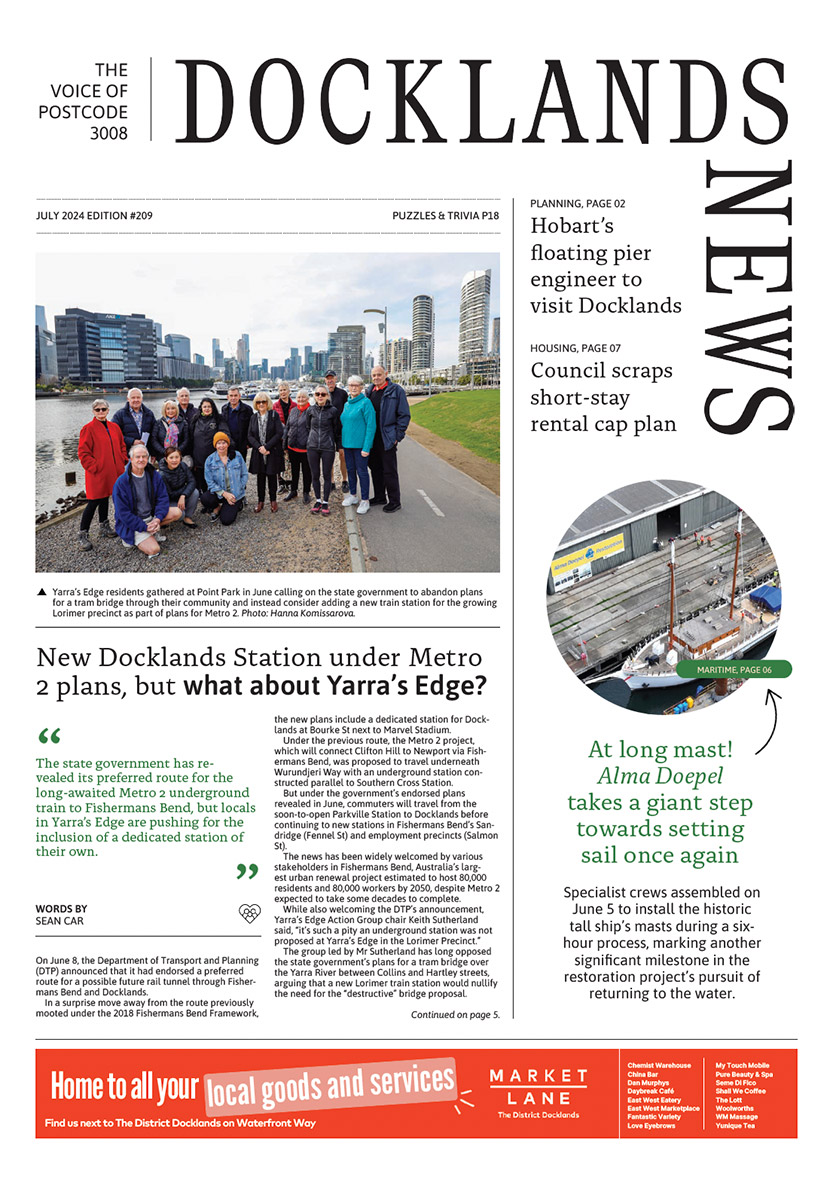Docklands’ big employers target two to three days per week office return
Large employers with thousands of office workers in Docklands expect most employees will return to a hybrid working model of two to three days per week in the office from the beginning of March.
ANZ, NAB and the Australian Taxation Office (ATO) — each with large offices in the local area — revealed plans for a staggered return after the Victorian Government removed office mask mandates and advice to work from home.
Hundreds of Docklands traders rely heavily on the presence of Monday-to-Friday corporate staff as clientele for their hospitality, retail and service businesses.
The two banks expect most employees to ease into a “hybrid” model of two to three days in the office per week, while the ATO went a step further and told Docklands News they expect full-time staff to (after an initial transition period) work “a minimum of three days in the office per week”.
While the easing of restrictions couldn’t happen sooner for small business owners, business groups expect the return to work to be slow, and not pick up until later in the year.
“Local traders aren’t that hopeful of a strong return to the workforce from the corporates,” Docklands Chamber of Commerce executive officer Shane Wylie said.
“We don’t believe there will be a meaningful return to in office work until later in the year.”
Mr Wylie said the presence of weekday workers in Docklands was heavily linked with the local economy, and their absence throughout the pandemic had already contributed to huge losses.
It is immensely important to the local Docklands economy as almost 100,000 people are not existing within the precinct on a daily basis. This has resulted in more than 40 per cent of local businesses shutting permanently over the past two years, and without a full return to the corporate workplace this pain will continue throughout 2022.
The comments come after Lord Mayor Sally Capp claimed “the shackles are off” following the state government’s announcement.
“People can now feel confident to come back into the city for work,” she said.
“Good coffees, long lunches, the theatre after work, pre-drinks before footy at the ‘G – the Melbourne we all love is here waiting for you.”
Premier Daniel Andrews noted the flow-on effect that lifting the mask restrictions would have on local businesses.
“Victorians can head back to work, without needing to wear a mask in the office. And cafes and lunch spots around Victoria can start to welcome back the regulars they’ve missed so much.”
This sentiment was similarly conveyed by NAB CEO Ross McEwan.
“Let’s say I get the average coming through and we get 10,000 per day, and they all come into town and they spend 10 bucks on a sandwich and a cup of coffee,” he said in an interview on 3AW.
“And you and I know you go down to the sushi bar, you’re going to be paying more than that. But let’s just say it’s $10, there’s $100,000 of income that goes into small businesses underneath my building.”
The move, however, represented a sharp shift in government policy.
Less than three weeks prior to the announcement that restrictions would ease, Mr Andrews said masks were “not coming off any time soon” when asked about the prospect of a wide-scale return to the office.
The lifting of restrictions ended the City of Melbourne’s growing frustration with the state government’s reluctance to ease mask mandates and work-from-home advice.
What they said ...
ANZ Group executive talent and culture, Kathryn van der Merwe
“For our people who are working in a blended or hybrid way, we’re not being prescriptive about what time they spend between the office and working remotely. We’re asking teams to work out the rhythm that works best for individuals, their team, the business and our customers. We expect that will become a regular and frequent occurrence in the coming months.”
NAB Group chief operating officer, Les Matheson
“[We] support hybrid working because it gives us the flexibility to balance time working from home and time working together. We know from speaking with you and our Heartbeat survey that the majority of you want this mix because it gives us the best of both worlds. As a relationship bank, most roles at NAB require face-to-face connection. This means a blend of two to three days a week from the office and two to three days a week at home. This hybrid approach provides colleagues with greater flexibility to integrate work with commitments at home and the need to attend the office for connection and collaboration.”
ATO spokesperson
“Following our initial transition period, going forward our approach will be that where an ATO employee seeks to work a portion of their week from home, staff can work with their manager to agree on suitable arrangements that satisfy the business requirements of the position, and are appropriate for their manager and broader team. There are well-researched benefits to office attendance.” •

New Docklands Station under Metro 2 plans, but what about Yarra’s Edge?








 Download the Latest Edition
Download the Latest Edition